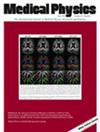Dose distributions of proton therapy plans are robust against lowering the resolution of CTs combined with increasing noise
Abstract
Background
Treatment planning in radiation therapy (RT) is performed on image sets acquired with commercial x-ray computed tomography (CT) scanners. Considering an increased frequency of verification scans for adaptive RT and the advent of alternatives to x-ray CTs, there is a need to review the requirements for image sets used in RT planning.
Purpose
This study aims to derive the required image quality (IQ) for the computation of the dose distribution in proton therapy (PT) regarding spatial resolution and the combination of spatial resolution and noise. The knowledge gained is used to explore the potential for dose reduction in tomography-guided PT.
Methods
Mathematical considerations indicate that the required spatial resolution for dose computation is on the scale of the set-up margins fed into the robust optimization. This hypothesis was tested by processing retrospectively 12 clinical PT cases, which reflect a variety of tumor localizations. Image sets were low-pass filtered and were made noisy in a generic manner. Dose distributions on the modified CT scans were computed with a Monte-Carlo dose engine. The similarity of these dose distributions with clinical ones was quantified with the gamma-index (1 mm/1%). The potential reduction of the x-ray exposure compared to the planning CT scan was estimated.
Results
Dose distributions within the irradiated volume were robust against low-pass filtering of the CTs with kernels up to a full-width-at-half-maximum of 4 mm, that is, the gamma pass rate (1 mm/1%) was 98%. The limit of the filter width was 6 mm for brain tumors and 8 mm for targets in the abdomen. These pass rates remained approximately unchanged if a limited amount of noise was added to the CT image sets. The estimated potential reductions of the x-ray exposure were at least a factor of 20.
Conclusions
The requirements on IQ in terms of spatial resolution in combination with noise for computing the dose in PT are clearly lower than the IQ of current clinical planning. The results apply, for example, to ultra-low dose x-ray CTs, proton CTs with coarse spatial detection, and attenuation images from the joint reconstruction of time-of-flight PET scans.


 求助内容:
求助内容: 应助结果提醒方式:
应助结果提醒方式:


